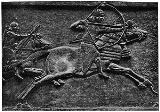
Military history of the Neo-Assyrian Empire
Encyclopedia
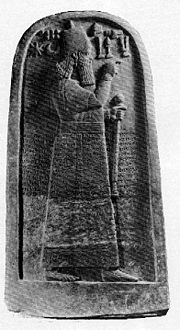
Assyria
Assyria was a Semitic Akkadian kingdom, extant as a nation state from the mid–23rd century BC to 608 BC centred on the Upper Tigris river, in northern Mesopotamia , that came to rule regional empires a number of times through history. It was named for its original capital, the ancient city of Assur...
originated in the 23rd century BC, its earliest king Tudiya
Tudiya
Tudiya is the earliest recorded Assyrian king. According to Georges Roux and the Assyrian King List he would have lived in the 23rd century BC. Tudiya concluded a treaty with king Ibrium of Ebla for the use of a trading post officially controlled by Ebla. He was suceeded by Adamu....
being a contemporary of Ibrium
Ibrium
Ibrium was an ancient ruler of the Kingdom of Ebla. He dominated Ebla and its subordinate cities and became its most powerful ruler. Ibrium introduced absolute, hereditary monarchy in the kingdom and was succeeded by his son Ibbi-Sipish....
of Ebla
Ebla
Ebla Idlib Governorate, Syria) was an ancient city about southwest of Aleppo. It was an important city-state in two periods, first in the late third millennium BC, then again between 1800 and 1650 BC....
. It evolved from the Akkadian Empire of the late 3rd millennium BC
3rd millennium BC
The 3rd millennium BC spans the Early to Middle Bronze Age.It represents a period of time in which imperialism, or the desire to conquer, grew to prominence, in the city states of the Middle East, but also throughout Eurasia, with Indo-European expansion to Anatolia, Europe and Central Asia. The...
. Assyria was a strong nation under the rule of Ilushuma
Ilushuma
Ilushuma was the king of Assyria ca. 1945–1906 BC. He was a powerful king who is best known for founding colonies in Asia Minor and leading an Assyrian army and raiding into southern Mesopotamia, attacking the Sumerian state of Isin and other states. Two of his sons went on to become kings: Erishum...
(1945- 1906 BC), who founded colonies in Asia Minor
Asia Minor
Asia Minor is a geographical location at the westernmost protrusion of Asia, also called Anatolia, and corresponds to the western two thirds of the Asian part of Turkey...
and raided Isin
Isin
Isin was an ancient city-state of lower Mesopotamia about 20 miles south of Nippur at the site of modern Ishan al-Bahriyat in Iraq's Al-Qādisiyyah Governorate.-History:...
and other Sumero-Akkadian states in southern Mesopotamia. Under Shamshi-Adad I
Shamshi-Adad I
Shamshi-Adad I Shamshi-Adad I Shamshi-Adad I (fl. late 18th century BC (short chronology) was an Assyrian king. He rose to prominence when he carved out an empire encompassing much of Mesopotamia, Syria and Asia Minor...
(1813- 1791 BC) and his successor Ishme-Dagan
Ishme-Dagan
Ishme-Dagan I was the son of the Assyrian king Shamshi-Adad I, put on throne of Ekallatum by his father after a successful military attack. He ruled the area of the upper Tigris, including the city-state of Assur. Following Shamshi-Adad's death , Ishme-Dagan I managed to rule Assyria until himself...
(1790- 1754 BC) Assyria was the seat of a regional empire controlling northern Mesopotamia and regions in Asia Minor and northern Syria. From 1365- 1076 BC Assyria became a major empire and world power, rivalling Egypt
Egypt
Egypt , officially the Arab Republic of Egypt, Arabic: , is a country mainly in North Africa, with the Sinai Peninsula forming a land bridge in Southwest Asia. Egypt is thus a transcontinental country, and a major power in Africa, the Mediterranean Basin, the Middle East and the Muslim world...
. Kings such as Ashur-uballit I
Ashur-uballit I
Ashur-uballit I , was king of the Assyrian empire . His reign marks Assyria's independence from the kingdom of Mitanni, by defeating Shuttarna II; and the beginning of Assyria's emergence as a powerful empire...
(1365 BC – 1330 BC), Enlil-nirari
Enlil-nirari
Enlil-nirari was King of Assyria from 1330 BC to 1319 BC, or from 1317 BC to 1308 BC . He was the son of Aššur-uballiṭ I...
(1329- 1308 BC), Arik-den-ili
Arik-den-ili
Arik-den-ili was an Assyrian king who succeeded Enlil-nirari, his father, and was to rule for twelve years and inaugurate the tradition of annual military campaigns against Assyria’s neighbors.-Biography:Our sources are slim for his reign, less than ten inscriptions, a fragmentary chronicle...
(c. 1307-1296 BC), Adad-nirari I
Adad-nirari I
Adad-nirari I was a king of Assyria. He is the earliest Assyrian king whose annals survive in any detail. Adad-nirari I achieved major military victories that significantly strengthened the Assyrian kingdom and enabled Assyria to start to play a major role in Mesopotamian politics...
(1295- 1275 BC), Shalmaneser I
Shalmaneser I
Shalmaneser I was a king of Assyria.Son of Adad-nirari I, he succeeded his father as king in 1265 BC....
(1274- 1245 BC), Tukulti-Ninurta I
Tukulti-Ninurta I
Tukulti-Ninurta I was a king of Assyria.He succeeded Shalmaneser I, his father, as king and won a major victory against the Hittites at the Battle of Nihriya in the first half of his reign...
(1244 BC -1208 BC), Ashur-resh-ishi I
Ashur-resh-ishi I
Ashur-resh-ishi I was King of Assyria from 1133 to 1115 BC. He succeeded his father, Mutakkil-Nusku, and was succeeded by his son Tiglath-Pileser I....
(1133 -1116 BC) and Tiglath-Pileser I
Tiglath-Pileser I
Tiglath-Pileser I was a king of Assyria during the Middle Assyrian period . According to Georges Roux, Tiglath-Pileser was "one of the two or three great Assyrian monarchs since the days of Shamshi-Adad I"...
(1115- 1077 BC) forged an empire which at its peak stretched from the Meditteranean to the Caspian
Caspian
Caspian can refer to:"Caspian" comes from the word "Gazvin" which is the name of a city in north of Iran and one of the nearest cities to the Caspian sea.*The Caspian Sea*The Caspian Depression, surrounding the northern part of the Caspian Sea...
, and from the foothills of the Caucasus
Caucasus
The Caucasus, also Caucas or Caucasia , is a geopolitical region at the border of Europe and Asia, and situated between the Black and the Caspian sea...
to Arabia. The 11th and 10th centuries BC were adark age
Greek Dark Ages
The Greek Dark Age or Ages also known as Geometric or Homeric Age are terms which have regularly been used to refer to the period of Greek history from the presumed Dorian invasion and end of the Mycenaean Palatial civilization around 1200 BC, to the first signs of the Greek city-states in the 9th...
for the entire Near East
Near East
The Near East is a geographical term that covers different countries for geographers, archeologists, and historians, on the one hand, and for political scientists, economists, and journalists, on the other...
, North Africa
North Africa
North Africa or Northern Africa is the northernmost region of the African continent, linked by the Sahara to Sub-Saharan Africa. Geopolitically, the United Nations definition of Northern Africa includes eight countries or territories; Algeria, Egypt, Libya, Morocco, South Sudan, Sudan, Tunisia, and...
, Caucasus
Caucasus
The Caucasus, also Caucas or Caucasia , is a geopolitical region at the border of Europe and Asia, and situated between the Black and the Caspian sea...
, Mediterranean and Balkan regions, with great upheavals and mass movements of people. Despite the apparent weakness of Assyria, at heart it in fact remained a solid, well defended nation whose warriors were the best in the world. Assyria, with its stable monarchy and secure borders was in a stronger position during this time than potential rivals such as Egypt
Egypt
Egypt , officially the Arab Republic of Egypt, Arabic: , is a country mainly in North Africa, with the Sinai Peninsula forming a land bridge in Southwest Asia. Egypt is thus a transcontinental country, and a major power in Africa, the Mediterranean Basin, the Middle East and the Muslim world...
, Babylonia
Babylonia
Babylonia was an ancient cultural region in central-southern Mesopotamia , with Babylon as its capital. Babylonia emerged as a major power when Hammurabi Babylonia was an ancient cultural region in central-southern Mesopotamia (present-day Iraq), with Babylon as its capital. Babylonia emerged as...
, Elam
Elam
Elam was an ancient civilization located in what is now southwest Iran. Elam was centered in the far west and the southwest of modern-day Iran, stretching from the lowlands of Khuzestan and Ilam Province, as well as a small part of southern Iraq...
, Phrygia
Phrygia
In antiquity, Phrygia was a kingdom in the west central part of Anatolia, in what is now modern-day Turkey. The Phrygians initially lived in the southern Balkans; according to Herodotus, under the name of Bryges , changing it to Phruges after their final migration to Anatolia, via the...
, Urartu
Urartu
Urartu , corresponding to Ararat or Kingdom of Van was an Iron Age kingdom centered around Lake Van in the Armenian Highland....
, Persia and Media Beginning with the campaigns of Adad-nirari II
Adad-nirari II
Adad-nirari II is generally considered to be the first King of Assyria in the Neo-Assyrian period. He firmly subjugated the areas previously under only nominal Assyrian vassalage, conquering and deporting troublesome Aramean, Neo-Hittite and Hurrian populations in the north to far-off places...
(911-892 BC), Assyria once more became a great power, growing to be the greatest empire the world had yet seen, although some historians do not regard it as a true empire in the modern sense until the reforms of Tiglath-Pileser III
Tiglath-Pileser III
Tiglath-Pileser III was a prominent king of Assyria in the eighth century BC and is widely regarded as the founder of the Neo-Assyrian Empire. Tiglath-Pileser III seized the Assyrian throne during a civil war and killed the royal family...
in the mid-8th century BC
8th century BC
The 8th century BC started the first day of 800 BC and ended the last day of 701 BC.-Overview:The 8th century BC was a period of great changes in civilizations. In Egypt, the 23rd and 24th dynasties led to rule from Nubia in the 25th Dynasty...
. The Assyrian empire has at times been described as the first military power in history. This article deals with the forces of the Assyrians in the above described times.
Ashurnasirpal II is credited for utilizing sound strategy in his wars of conquest. While aiming to secure defensible frontiers, he would launch raids further inland against his opponents as a means of securing economic benefit, as he did when campaigning in the Levant. The result meant that the economic prosperity of the region would fuel the Assyrian war machine.
Ashurnasirpal II was succeeded by Shalmaneser III
Shalmaneser III
Shalmaneser III was king of Assyria , and son of the previous ruler, Ashurnasirpal II....
. Although he campaigned for 31 years of his 35 year reign, he failed to achieve or equal the conquests of his predecessor, and his death led to another period of weakness in Assyrian rule.
Assyria would later recover under Tiglath Pileser III whose reforms once again made Assyria the most powerful force in the Near East, and transformed her into a fully fledged empire - the first of its kind. Later, under Shalmaneser V
Shalmaneser V
Shalmaneser V was king of Assyria from 727 to 722 BC. He first appears as governor of Zimirra in Phoenicia in the reign of his father, Tiglath-Pileser III....
, Sargon II
Sargon II
Sargon II was an Assyrian king. Sargon II became co-regent with Shalmaneser V in 722 BC, and became the sole ruler of the kingdom of Assyria in 722 BC after the death of Shalmaneser V. It is not clear whether he was the son of Tiglath-Pileser III or a usurper unrelated to the royal family...
and Sennacherib
Sennacherib
Sennacherib |Sîn]] has replaced brothers for me"; Aramaic: ) was the son of Sargon II, whom he succeeded on the throne of Assyria .-Rise to power:...
further Assyrian offensives occurred, although these were designed not only for conquest, but also to destroy the enemies ability to undermine Assyrian power. As such, costly battles raged taking tolls on Assyrian manpower. Esarhaddon
Esarhaddon
Esarhaddon , was a king of Assyria who reigned 681 – 669 BC. He was the youngest son of Sennacherib and the Aramean queen Naqi'a , Sennacherib's second wife....
succeeded in taking lower Egypt and his successor, Ashurbanipal
Ashurbanipal
Ashurbanipal |Ashur]] is creator of an heir"; 685 BC – c. 627 BC), also spelled Assurbanipal or Ashshurbanipal, was an Assyrian king, the son of Esarhaddon and the last great king of the Neo-Assyrian Empire...
, took the southern upper half of Egypt.
However, by the end of the Ashurbanipal's reign it appears that the Assyrian Empire was falling into another period of weakness, one from which she would not escape. It appears that years of costly battles followed by constant (and almost unstoppable) rebellions meant that it was a matter of time before Assyria ran out of troops. The loss of the outer regions meant that foreign troops were gone too. By 605 BC, independent political Assyrian records vanish from history and the Assyrians lost their independence forever.
Background
MesopotamiaMesopotamia
Mesopotamia is a toponym for the area of the Tigris–Euphrates river system, largely corresponding to modern-day Iraq, northeastern Syria, southeastern Turkey and southwestern Iran.Widely considered to be the cradle of civilization, Bronze Age Mesopotamia included Sumer and the...
was the site of some of the earliest recorded battles in history. In fact, the first recorded battle was between the forces of Lagash
Lagash
Lagash is located northwest of the junction of the Euphrates and Tigris rivers and east of Uruk, about east of the modern town of Ash Shatrah. Lagash was one of the oldest cities of the Ancient Near East...
and Umma
Umma
Umma was an ancient city in Sumer. Note that there is some scholarly debateabout the Sumerian and Akkadian names for this site.-History:...
c.2450 BC. Like many Mesopotamian records, it contains elements of fiction. The ruler of Lagash, Eanatum, was inspired by the god Ningirsu to attack the rival kingdom of Umma; the two were involved in minor skirmishes and raids along their respective borders. Eanatum, although the attacker, triumphed, even though he was struck in the eye by an arrow. After the battle, he proudly documented the behavior of the vultures.
Akkadian and Old Assyrian
According to legend, Sargon, the first king of the Akkadian Kingdom, was discovered by a gardener in Mesopotamia in a basket. In time, he would found the city of Agade and raise an army of 5,400 men, and then conquer much of modern-day Iraq. His inscriptions boasts of 34 victories and "5,400 men eating bread before Sargon", exemplifying both the vast manpower and the obedience of his troops (and possibly a standing army as well). Though small by even the standards of later kings, Sargon's army was larger and more sophisticated than others of the time, utilizing a combination of spears and missile weapons. Bronze swords and four wheeled chariots brushed aside any resistance as he carved out his empire, which may well have included (at least briefly) parts of the Mediterranean, AnatoliaAnatolia
Anatolia is a geographic and historical term denoting the westernmost protrusion of Asia, comprising the majority of the Republic of Turkey...
and western Iran
Iran
Iran , officially the Islamic Republic of Iran , is a country in Southern and Western Asia. The name "Iran" has been in use natively since the Sassanian era and came into use internationally in 1935, before which the country was known to the Western world as Persia...
. Siege warfare was not a problem; most of the cities that were walled at the time of Sargon were made of mud and his inscriptions further boast of the destruction he brought on the walls of captured cities.
Though he utilized simple tactics that would be later emulated in many states, his dynasty survived for another 125 years. Assyrian, Babylonian and even Persian conquerors would claim to be Sargon's successors and attempted to emulate his great military success.
Middle Assyrian
Information on the Assyrian army during this time is difficult to make out - the Assyrians were able to establish their independence on two occasions, during the Old Assyrian KingdomAssyria
Assyria was a Semitic Akkadian kingdom, extant as a nation state from the mid–23rd century BC to 608 BC centred on the Upper Tigris river, in northern Mesopotamia , that came to rule regional empires a number of times through history. It was named for its original capital, the ancient city of Assur...
and the Middle Assyrian Kingdom
Assyria
Assyria was a Semitic Akkadian kingdom, extant as a nation state from the mid–23rd century BC to 608 BC centred on the Upper Tigris river, in northern Mesopotamia , that came to rule regional empires a number of times through history. It was named for its original capital, the ancient city of Assur...
, with the latter reaching as far as Babylon
Babylon
Babylon was an Akkadian city-state of ancient Mesopotamia, the remains of which are found in present-day Al Hillah, Babil Province, Iraq, about 85 kilometers south of Baghdad...
in their pursuit of conquest. However, military tactics mainly involved using troops raised from farmers who had finished planting their fields and so could campaign for the king until harvest time called for their attention again. The result was that military campaigning was limited to a few months of the year. As a result, armies could not conquer vast amounts of land without having to rest (and hence allow their enemy to recover) and even if they did they would not be able to garrison conquered lands with troops for long.
Organization of the Military
The Assyrian army's hierarchyHierarchy
A hierarchy is an arrangement of items in which the items are represented as being "above," "below," or "at the same level as" one another...
was typical of the Mesopotamian armies at the time. The King whose rule was sanctioned by the gods, would be the commander of the entire army of the Empire. He would appoint senior officers on certain occasions to campaign in his place if his presence on the battlefield could or had to be spared.
Sargon of Akkad
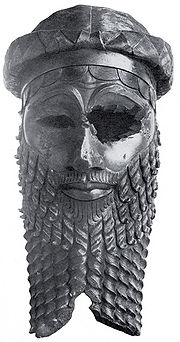
Pre-reform
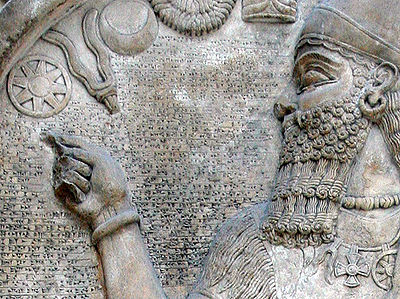
Assyrian armies could be very large; Shalmaneser III once boasted a force of 120,000 men in his campaigns against Syria. Such a force required men to be extracted from conquered peoples. A large army also needed more food and supplies and for this the Assyrians organized what they needed for a campaign before they set out.
Preparations for a new campaign
Preparations for a new campaign required first and foremost the assembly of troops at a designated base. In Assyria, the designated locations included Nineveh, Kalhu or Khorsabad. On some occasions the designated meeting points would change depending upon the campaign. Governors were instructed to accumulate supplies of corn, oil and war material. Other requirements of the Governors included calling up the needed man power. Vassal states were in particular required to present troops as part of their tribute to the Assyrian King and in good time - failure to do so, would have almost certainly been seen as an act of rebellion.The arrival of the King and his bodyguard ended the preliminary stage and the army would move on to the target of their campaign. The army would march in good order; in the vanguard came the standard of the Gods, signifying the servitude of the Assyrian Kings to their primary God Assur. Following this was the King, the humble servant of Assur surrounded by his bodyguard with the support of the main chariot divisions and cavalry, the elite of the army. In the rear was the infantry; the Assyrian troops followed by the conquered peoples. Following this would be the siege train, supply wagons and then the camp followers. Such a formation would have been very vulnerable to a rear attack. Some columns of troops could travel 30 miles a day and such speed would have been used to surprise and frighten an opponent into submission.
Reforms of Tiglath-Pileser III
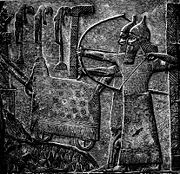
All was to change when Tiglath Pileser III came to the throne in 745 BC. After increasing the efficiency of the Assyrian administration, he went on to change the Assyrian army as well. The most important aspect of his reform was the introduction of a standing army. This included a larger number of foreign soldiers but mixed in with other Assyrian soldiers. These men could be supplied by vassal states as tribute or when demanded by the Assyrian King. They were given Assyrian equipment and uniform which made them indistinguishable from one another, possibly to increase their integration. While the infantry in the standing army contained a large number of foreigners (including Aramaeans and even Greeks), the Assyrian cavalry and charioteers continued to be dominated by Assyrians. There were exceptions however, and as casualties mounted additional troops would not be unwelcome; Sargon II reports that he managed to incorporate 60 Israelite Chariot teams into his army.
Transportation and communication
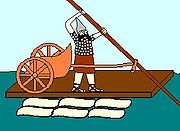
Rugged mountains were cut through thus greatly decreasing travel time. Engineers built fine stone pavements leading up to the grand cities of Assur
Assur
Assur , was one of the capitals of ancient Assyria. The remains of the city are situated on the western bank of river Tigris, north of the confluence with the tributary Little Zab river, in modern day Iraq, more precisely in the Al-Shirqat District .Assur is also...
and Nineveh
Nineveh
Nineveh was an ancient Assyrian city on the eastern bank of the Tigris River, and capital of the Neo Assyrian Empire. Its ruins are across the river from the modern-day major city of Mosul, in the Ninawa Governorate of Iraq....
, so as to impress foreigners with the wealth of Assyria. By the 2nd millennium BC, wooden bridges were built across the Euphrates
Euphrates
The Euphrates is the longest and one of the most historically important rivers of Western Asia. Together with the Tigris, it is one of the two defining rivers of Mesopotamia...
. By the 1st millennium BC, Nineveh and Assur had stone bridges, testament to the wealth of the kingdom of Ashur. The construction of roads and increased transport meant that goods would flow through the empire with greater ease, thus feeding the Assyrian war effort further. Of course, roads that sped up Assyrian troops would not discriminate and would also speed up enemy troops as well.
Use of camels
The Assyrians were the first to use Camels as beasts of burden for their military campaigns. Camels were of greater use than Donkeys because they can carry five times the load and yet require less watering. Camels were not domesticated until shortly before 1000 BC, on the eve of the Neo-Assyrian Empire.Wheeled vehicles
Although the Sumerians are credited for inventing the wheel sometime before 3000 BC, the Assyrians were the first to manufacture tires of metal, made from copper, bronze and later iron. Metal-covered wheels have the obvious advantage of being more durable and when overrunning an opponent in battle, will have a greater effect.Chariots
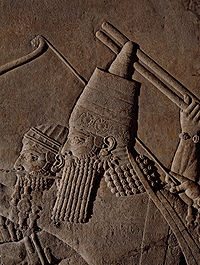
Battlefield
A battlefield refers to the location of a battle.Battlefield may also refer to:-In music:*"Battlefield", a song by Diana Ross from her 1991 album The Force Behind the Power* Battlefield Band, a Scottish traditional music group...
.
Cavalry
CavalryCavalry
Cavalry or horsemen were soldiers or warriors who fought mounted on horseback. Cavalry were historically the third oldest and the most mobile of the combat arms...
were rarely used by the Assyrians or many other Mesopotamians until the 9th century BC when their use is mentioned during the reign of Tukulti-Ninurta II
Tukulti-Ninurta II
Tukulti-Ninurta II was King of Assyria from 891 BC to 884 BC. He was the second king of the Neo Assyrian Empire.-Family:His father was Adad-nirari II, the second king of the Neo-Assyrian period. His son succeeded him and was named Ashurnasirpal II...
. Before then, many nomads or steppe warriors relied on cavalry, who raided Assyrian lands. The Assyrians had to counter this mobile form of warfare and so beat their opponents (notably the Iranians) at their own game. Perhaps the greatest outside influence is that of the Iranian Medes
Medes
The MedesThe Medes...
. It is ironic that the raiding by that people assisted Assyrian attempts in building a cavalry army with which to destroy the Kingdom of Elam. However, Assyrian attempts were not without difficulties; horse archers were utilized but could not use their bows and the reins of their horses at the same time. As a result, Cavalry under Ashurnasirpal are depicted in pairs, with one rider holding both reins and the other shooting with a bow.

Large units of cavalry were required to be deployed by the Assyrians; some units would consist of hundreds or even a thousand horsemen. There is little doubt that without a continuous supply of horses, the Assyrian war machine would have collapsed. As the empire suffered horrendous casualties under Ashurbanipal's campaigns of conquest, the rebellions following his death may have contributed significantly to the downfall of the empire as fewer vassals were available to pay tribute horses and other war material needed. Horses were an incredibly important war resource and the Assyrian king himself took a personal interest to oversee adequate horse supply.
Three main sources of horses were:
- Raids designed to steal horses from opponents, albeit from Scythians or other steppe peoples.
- Tribute paid by vassal states.
- High-ranking state officers would oversee horse production and report to the King.
Horses would be drawn from outlying provinces and brought in to be trained with new recruits for war.
Infantry
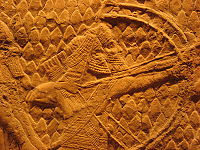
Assyrian Infantry were composed of both native Assyrians and foreigners employed as auxiliaries
Auxiliaries
An auxiliary force is a group affiliated with, but not part of, a military or police organization. In some cases, auxiliaries are armed forces operating in the same manner as regular soldiers...
, spearmen, slingers, shield bearers or archers. The latter type was the most dominant in Assyrian armies. From the time of Ashurnasirpal, archers would be accompanied by a shield bearer while slingers would aim to distract the enemy into lowering their shield to protect against the stones, thereby allowing the archers to shoot above their shield walls and slay their enemies. Even in siege warfare, arrows were used to drive back defenders from the wall while engineers advanced against the fortifications. Many different types of bows are recorded by the Assyrians, including Akkadian, Cimmerian and their own "Assyrian" type. However, it is most likely that these were simply different variants of the powerful composite bow. Depending upon the bow, an archer would have a range of anything between 250 to 650 meters. Vast amounts of arrows could be expended in battle so in preparation for war many arrows would be made. Facilities also existed that would travel with the army's supply train that could manufacture more arrows. An Assyrian army without arrows was an army without the main capability to win.
Lancers were introduced to the infantry under Tiglath-pileser III. The idea was that a long spear would be able to penetrate and attack the enemy's ranks at longer range than a sword or a dagger could. Armour (lamellar) amongst the melee troops was limited to elite soldiers only, while the rest of the army made do with shields and helmets.
Tactics
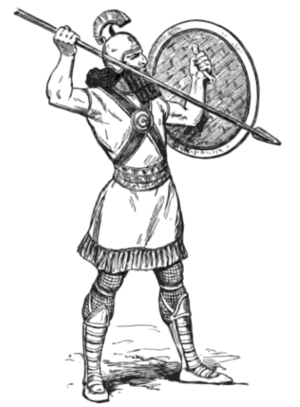
Pyrrhic victory
A Pyrrhic victory is a victory with such a devastating cost to the victor that it carries the implication that another such victory will ultimately cause defeat.-Origin:...
(in which he claims total victory):
Assyrian frontal offensives were designed to shock the enemy and surprise them. However, they were also a strategy employed when time was not on their side:
Despite the above, Sargon II's instinct saved the day; leading his exhausted troops, he launched a surprise attack against his Urartian opponents who broke at the speed and surprise of the attack. So vicious was the battle that the Urartian King abandoned his state officials, governors, 230 members of the Royal family, many cavalry and infantry and even the capital itself was abandoned.
Overall war strategy
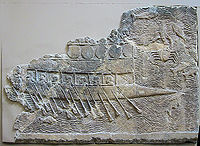
Colonization: The Assyrians, in conjunction with their deportation (see below) would also send some of their own into foreign lands and settle them as colonists. The primary aim was to establish a loyal power base; taxes, food and troops could be raised here as reliably as at their homeland, or at least it must have been hoped. Furthermore, their presence would bring innumerable benefits; resistance to other conquerors, a counter to any rebellions by the natives and assist the provincial Assyrian governors in ensuring that the vassal state was loyal to Assyria.
Total Destruction: One must be careful before assuming that the Assyrians utilized total war
Total war
Total war is a war in which a belligerent engages in the complete mobilization of fully available resources and population.In the mid-19th century, "total war" was identified by scholars as a separate class of warfare...
. However, it is known that the Assyrians, as part of their overall strategy of weakening their opponents and of exacting revenge would violently destroy what they could not take back or could not consolidate.:
Psychological warfare
The Assyrians fully appreciated the use of terrorizing their enemies. To conserve manpower and rapidly move on to solve Assyria's multiple problems, the Assyrians preferred to accept the surrender of their opponents or else destroy their ability to resist a surrender. This in part explains their offensive strategy and tactics.Deportations
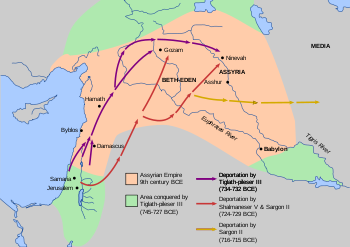
1) Psychological warfare: the possibility of deportation would have terrorized the people;
2) Integration: a multiethnic population base in each region would have curbed nationalist sentiment, making the running of the Empire smoother;
3) Preservation of human resources: rather than being butchered, the people could serve as slave labor or as conscripts in the army.
By the 9th century BC the Assyrians made it a habit of regularly deporting thousands of restless subjects to other lands. Re-settling these people in the Assyrian homeland would have undermined the powerbase of the Assyrian Empire if they would rebel again. As a result, Assyrian deportation involved removing one enemy population and settling them into another. Below is a list of deportations carried out by Assyrian Kings:
- 744 BC Tiglath Pileser III deports 65,000 people from Iran to the Assyrian-Babylonian border at the Diyala river
- 742 BC Tiglath Pileser III deports 30,000 people from Hamath, Syria and into the Zagros mountains in the east.
- 721 BC Sargon II (claimed) deports 27,290 people from Samaria, Israel and disperses them throughout the Empire. However, it is likely that his ousted predecessor, Shalmaneser V ordered the deportation
- 707 BC Sargon II deports 108,000 Chaldeans and Babylonians from the Babylonian region
- 703 BC Sennacherib deports 208,000 people from Babylon
Tiglath Pileser III re-introduced deportation on a grand scale, deporting tens, even hundreds of thousands of people. Deportations were also coupled with Colonization, see above for more details.
Dealing with rebels
When rebellion inevitably broke out in the Assyrian Empire, the Assyrian Kings would often brutally crush the rebellion (as an alternative to deportation) and inflict great punishments on her rebellious vassals. Ashurnasirpal II ensured that the rebellions he suffered would be crushed with the same ruthlessness so that his opponents would never wish to do so again; in this way he was utilizing psychological warfare:Ashurnasirpal II paints a descriptive picture when he later describes how he dealt with the rebels; they were flayed, impaled, beheaded (first if they were lucky), burnt alive, eyes ripped out, fingers, noses and ears cut off.
Ashurnasirpal II's brutal treatment succeeded in pacifying the rebels. As he campaigned into Syria, he was able to take a large body of soldiers out of Mesopotamia without fear of a rebellion cutting his supply lines. So successful were his brutal sieges of the cities of northern Syria that many other smaller settlements immediately surrendered to his army as it marched south parallel to the Mediterranean.
The Assyrians viewed their Kings as governing with the gods' (or the god Ashur) sanction. To rebel against this most humble servant of Ashur would be to rebel against Ashur himself, something that could only bring divine destruction; hence the glorification of such brutality.
Other acts of brutality include: rape, mutilating men until death, placing heads, arms, hands and even lower lips on the conquered city's walls, skulls and noses atop stakes. Alternatively these could also be piled up or even their corpses cut up and fed to the dogs. On some occasions, people were blinded so that as they wandered throughout the land they would speak of Assyrian terrors and demoralize the local population.
Siege warfare
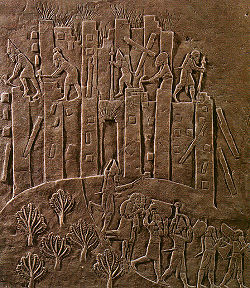
Susa
Susa was an ancient city of the Elamite, Persian and Parthian empires of Iran. It is located in the lower Zagros Mountains about east of the Tigris River, between the Karkheh and Dez Rivers....
apparently participated on the other side. A tablet unearthed in 1854 by Austen Henry Layard
Austen Henry Layard
Sir Austen Henry Layard GCB, PC was a British traveller, archaeologist, cuneiformist, art historian, draughtsman, collector, author, politician and diplomat, best known as the excavator of Nimrud.-Family:...
in Nineveh
Nineveh
Nineveh was an ancient Assyrian city on the eastern bank of the Tigris River, and capital of the Neo Assyrian Empire. Its ruins are across the river from the modern-day major city of Mosul, in the Ninawa Governorate of Iraq....
reveals Ashurbanipal as an "avenger", seeking retribution for the humiliations the Elamites had inflicted on the Mesopotamians over the centuries. Ashurbanipal dictates Assyrian retribution after his successful siege of Susa:
The plains and fertile lands of Mesopotamia were not only ideal for warfare: they actually attracted war. Raiders from all nations coveted the lands of the Assyrians - Scythians to the north, Syrians
Demographics of Syria
Syrians today are an overall indigenous Levantine people. While modern-day Syrians are commonly described as Arabs by virtue of their modern-day language and bonds to Arab culture and history...
, Arameans and Cimmerians
Cimmerians
The Cimmerians or Kimmerians were ancient equestrian nomads of Indo-European origin.According to the Greek historian Herodotus, of the 5th century BC, the Cimmerians inhabited the region north of the Caucasus and the Black Sea during the 8th and 7th centuries BC, in what is now Ukraine and Russia...
to the West, Elamites to the East and Babylonians to the south. In fact, the latter never tired of rebelling against Assyrian rule. As a result, in order to prevent chariots and cavalry from completely overwhelming these settlements, walls were constructed though often from mud or clay since stone was neither cheap, nor readily available. In order to destroy the opponents, these cities had to be taken as well and so the Assyrians soon mastered Siege warfare - Esarhaddon claims to have taken Memphis, the capital of Egypt in less than a day, demonstrating the ferocity and skill of Assyrian siege tactics at this point in time:
Sieges were costly in terms of manpower and more so if an assault was launched to take the city by force - the siege of Lachish cost the Assyrians at least 1,500 men - found at a mass grave near Lachish. Before the advent of standing armies, a city's best hope would be that the harvest would force the enemy to return to their fields and therefore abandon the city. However, with the reforms of Tiglath Pileser III Assyria's first standing army was forged and could therefore blockade a city until it surrendered instead. Nonetheless it is known that Assyrians always preferred to take a city by assault then to settle down for a blockade - the former method would be followed by extermination or deportation of the inhabitants and would therefore frighten the opponents of Assyria into surrendering as well.
Siege weapons
The Assyrians were not naturals at siege warfare and this can be seen by their attempts to experiment with numerous methods for taking a city.The most common siege weapon and by far the cheapest was the ladder. However, ladders are easy to topple over and so the Assyrians would shower their opponents with arrows to provide cover fire
. These archers in turn would be supported by shield bearers. Other ways of undermining the enemies' defences included mining. A 9th century Assyrian relief
Relief
Relief is a sculptural technique. The term relief is from the Latin verb levo, to raise. To create a sculpture in relief is thus to give the impression that the sculpted material has been raised above the background plane...
depicts soldiers using ladders to scale walls, while others use their spears to scrape the mud and clay from the walls. A soldier is also depicted beneath a wall, suggesting that mining was used to undermine the foundations and bring the walls down on their opponents.
The Battering ram appears to be one of the best Assyrian contributions to siege warfare. Although looking nothing like the tougher weapons used by the Greeks and Romans many centuries later, they nonetheless served their purpose. They consisted of a tank-like wooden frame on four wheels. There was a small tower on top for archers to provide covering fire as the engine moved forward. When it had reached its destination, its primary weapon, a large spear, was used to batter away and chip pieces of the enemy wall. While this would have been almost useless against stone walls, one must keep in mind that mud and not stone was used to build walls. Even when dried, these mud walls could be attacked with such engines. Walls were strengthened with time and the Assyrians responded by building larger engines with bigger "spears". In time, they closely resembled a large and long log with a metal tip at the end. Even stone would not withstand pounding by a larger weapon. Larger engines accommodated greater numbers of archers. To protect against fire (which was used by both sides at the Siege of Lachish) the battering ram would be covered in wet skins. These could be watered at any time in battle in case they dried.
Siege towers, even ones that could float were reported to have been in use whenever there was a wall facing a river.
3rd and 2nd Millennia BC
- 2340–2284 BC Sargon of AkkadSargon of AkkadSargon of Akkad, also known as Sargon the Great "the Great King" , was an Akkadian emperor famous for his conquest of the Sumerian city-states in the 23rd and 22nd centuries BC. The founder of the Dynasty of Akkad, Sargon reigned in the last quarter of the third millennium BC...
conquers much of Mesopotamia - 1230 BC Battle of Nairi
- 1170 BC Nineveh is stronger than ever with more power than ever
9th century BC
Cavalry use first recorded by Tukulti Ninurta II- 883 BC Ashurnasirpal II takes power and begins expansion of Assyria beyond Mesopotamia
- 877 BC Ashurnasirpal II takes Assyrian troops to the Mediterranean and Mount Lebanon for the first time.
- 858 BC Shalmaneser III subjugates Bit Adini to vassal status
- 853 BC After taking Aleppo, Shalmaneser III is stopped at the Battle of QarqarBattle of QarqarThe Battle of Qarqar was fought in 853 BC when the army of Assyria led by king Shalmaneser III encountered an allied army of 12 kings at Qarqar led by Hadadezer of Damascus and King Ahab of Israel...
- 851 BC Shalmaneser III defeats Chaldean revolt in Babylon
- 849, 845 and 841 BC Shalmaneser III makes three unsuccessful attempts to take Syria
- 840 BC Shalmaneser III fails to defeat Urartu
- 832 BC Shalmaneser III fails to take Damascus in a siege
- 824 BC Shalmaneser III dies, Assyria enters into period of weakness
8th century BC
- 780 - 756 BC Argistis I reigns over Assyria, lake Urmia lost by Assyria to Urartu
- 745 BC Tiglath Pileser III seizes power in a coup; Assyrian Army reformed
- 744 BC Mass deportation of Iranians by Tiglath Pileser III
- Unknown date: Tiglath Pileser III defeats Babylon
- 743 BC Tiglath Pileser III decisively defeats Urartu, besieges Arpad
- 741 BC Arpad falls to Tiglath Pileser III
- 734 - 732 BC Syro-Ephraimite WarSyro-Ephraimite WarThe Syro-Ephraimite War took place in the 8th century BC, when Assyria was a great regional power. The smaller nations of Syria and the northern Kingdom of Israel formed a coalition in defense against the oncoming threat. They had previously been tributary nations to Assyria, and they finally...
: Rebellions in Syria and Palestine are crushed. Damascus falls in 732. - 732 BC Babylon is conquered by Assyria following an usurpation of the throne by a Chaldean. Lands around Babylon are devastated during three years of fighting
- 724 - 722 BC Shalmaneser V besieges and then captures Samaria
- 721 BC Coup of Sargon II results in Samaria revolt; it is quickly crushed.
- 721 BC Sargon II defeats Babylonian rebellion
- 717 - 716 BC Sargon II takes Carchemish to secure trade routes in the north.
- 714 BC A major military disaster befalls Urartu; Sargon II destroys Urartu's ability to fight forever
- 713 BC Rumours of an anti-Assyrian alliance leads Sargon II to take Tabal.
- 710 - 707 BC Another Babylonian revolt is crushed by Sargon II
- 709 BC Assyrian expeditionary forces sent by Sargon II force Midas to seek peace terms.
- 703 BC Another Chaldean-backed Babylon revolt is crushed by Sennacherib, only one year after his succession
- 701 BC Sennacherib moves down Mediterranean coast to subdue Syria and Israel. Lachish is taken after bloody fighting, while Egyptian aid is driven back. Siege of Jerusalem fails.
7th century BC
- 694 BC Sennacherib attacks Elam. Elam attacks Babylon, which is now unoccupied by Assyrian army
- 693 BC Battle of Diyala RiverBattle of Diyala RiverThe Battle of Diyala River took place in 693 BC between the forces of the Assyrian empire and the Elamites of southern Iran.-Assyrian expansion:...
: Assyrian assault to Elam through Der is called back due to Babylonian revolt - 692 BC Battle of HaluleBattle of HaluleThe Battle of Halule took place in 691 BC between the Assyrian empire and the rebelling forces of the Babylonians, Chaldeans, and Aramaic tribes.- Background :During the reign of king Sennacherib of Assyria Babylonia was in a constant state of revolt...
: The alliance of Elamites, Babylonians, Chaldeans, and Aramaic and Zagros tribes fight off the Assyrians. - 691 BC Sennacherib wins a Pyrrhic victory against Elam. However he is able to crush the Babylon revolt
- 681 BC Sennacherib is murdered by two of his sons; another son Esarhaddon avenges his death and rules Assyria
- 679 BC An alliance of Cimmerians and Scythians is defeated by Esarhaddon's forces.
- 679 BC Esarhaddon's troops take Arzani and reach the Egyptian border.
- 676 BC Esarhaddon launches an offensive to counter increasing Iranian power.
- 675 BC An assault on Egypt is thrown back.
- 671 BC Another Assyrian offensive into Egypt is a success;
- 669 BC Memphis is sacked by Assyrian troops
- 668 BC Ashurbanipal succeeds Esarhhadon, last King of Assyria to expand her borders beyond Mesopotamia
- 663 BC Ashurbanipal relieves an Egyptian siege of Memphis and destroys Thebes in the south.
- 665 BC A ten year campaign against Media is launched.
- 665 BC Elam attacks Babylon, but fails.
- 655 BC Elam attacks Babylon. At the same time, Egypt launches another offensive. Elamite attack repelled by large Assyrian army assembled by Ashurbanipal.
- Unknown date (possibly 655 BC) Ashurbanipal drives Elmite forces across the River Ulai in the plain of Susa.
- 653 BC Median invasion stopped by Scythian attack
- 652 BC Babylon once more revolts
- 651 BC Ashurbanipal abandons Egypt to focus on Elamite attacks; Assyrian army shows signs of overstretching itself.
- 648 BC Babylon is utterly destroyed by Assyria; Elamite civil war ensures no help from Elam.
- 647 BC Battle of SusaBattle of SusaThe Battle of Susa was a battle involving Assyrians and Elamites. The Assyrian king Ashurbanipal, had grown tired of the Elamites' attacks on the Mesopotamians, and he decided to destroy Susa as punishment....
: Susa is destroyed completely by Ashurbanipal. - 639 BC Ashurbanipal decimates the lands of Elam. Elamite kingdom does not recover.
Collapse of Assyria
- 635 BC Egypt, unchecked since 651 BC, storms Ashdod.
- 627 BC Ashurbanipal dies. Collapse of Assyria accelerates.
- 622 BC An Assyrian expedition may have been launched west of the Euphrates; lack of Assyrian records points to a likely Assyrian defeat.
- 616 BC Nabopolassar, King of Babylon since 626 BC, drives out Assyrian troops from Babylonia.
- 615 BC Median invasion of Assyria results in capture of Arrapha.
- 614 BC Assur, first Capital of Assyria is sacked by the Medes under King Cyaxares.
- 612 BC Battle of Nineveh (612 BC)Battle of Nineveh (612 BC)The Battle of Nineveh was fought in 612 BC. It witnessed the Assyrian capital of Nineveh being besieged, conquered, and sacked by allied forces of Medes, Scythians, Babylonians and Susianians. King Sin-shar-ishkun of Assyria was killed in the sack.From then on, the Neo-Babylonian Empire ruled the...
: Nineveh is destroyed by an alliance of Medians and Babylonians after a mere 3 month siege. - 609 BC Battle of Megiddo (609 BC)Battle of Megiddo (609 BC)This Battle of Megiddo is recorded as having taken place in 609 BC with Necho II of Egypt leading his army to Carchemish to fight with his allies the Assyrians against the Babylonians at Carchemish in northern Syria. This required passing through territory controlled by the Kingdom of Judah and...
: Egyptians unsuccessfully tried to help the Assyrians. - 608 BC Newly established Assyrian capital at Harran is destroyed by pursuing Babylonian forces.
- 605 BC Battle of CarchemishBattle of CarchemishThe Battle of Carchemish was fought about 605 BC between the allied armies of Egypt and Assyria against Babylonia.- Background :When the Assyrian capital Nineveh was overrun by the Babylonians in 612 BC, the Assyrians moved their capital to Harran...
: Egypt, fearing the power of Babylon, assists Assyria. An Assyrian-Egyptian alliance is crushed by a Babylonian army. Assyria ceases to exist as an independent nation.
See also
- Ancient warfareAncient warfareAncient warfare is war as conducted from the beginnings of recorded history to the end of the ancient period. In Europe and the Near East, the end of antiquity is often equated with the fall of Rome in 476, and the wars of the Eastern Roman Empire Byzantium in its South Western Asian and North...
- Assyrian LeviesAssyrian LeviesThe Iraq Levies was the first Iraqi military forces established by the British in British controlled Iraq. The Iraq Levies were a most noteworthy feature of the Kingdom of Iraq, and especially of northern Iraq during the years of the mandate, and no account of the Assyrians or indeed of Iraq itself...
- Military history of IraqMilitary history of IraqThe military history of Iraq, due to a rich archaeological record, is one of the longest in written human history. The region of Iraq, which used to be Mesopotamia, has been referred to as the "cradle of civilization", and wars of conquest have been recorded in this region as far back as the third...
- List of artifacts significant to the Bible
- Military history of IranMilitary history of IranWith thousands of years of recorded history, and due to an unchanging geographic condition, Iran has had a long, varied, and checkered military culture and history, ranging from triumphant and unchallenged ancient military supremacy affording effective superpower status in its day, to a series of...
- Military history of Egypt
- Syro-Ephraimite WarSyro-Ephraimite WarThe Syro-Ephraimite War took place in the 8th century BC, when Assyria was a great regional power. The smaller nations of Syria and the northern Kingdom of Israel formed a coalition in defense against the oncoming threat. They had previously been tributary nations to Assyria, and they finally...

